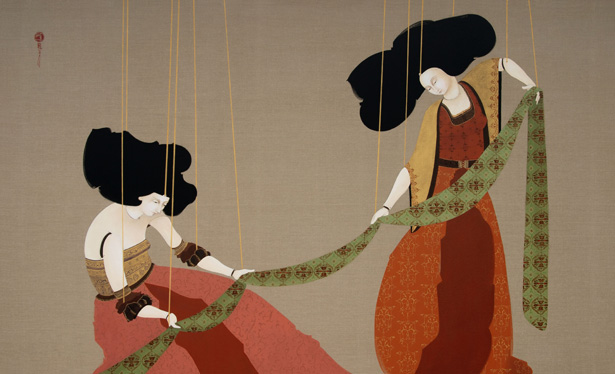Disquieting Muses
5 July–4 September 2011
Contemporary Art Center of Thessaloniki
Warehouse Β1, Thessaloniki port area, Greece
Curator: Syrago Tsiara, Director CACT
State Museum of Contemporary Art
21st Kolokotroni str. Stavroupoli 56430, Thessaloniki, Greece
Τ + 30 2310 589140-1 & 3, F +30 2310 600123
www.greekstatemuseum.com, info [at] greekstatemuseum.com
press [at] greekstatemusuem.com
Exhibition opening hours:
Tuesday–Sunday: 11:00–19:00
In 1957, almost forty years after Giorgio de Chirico’s painting “Τhe Disquieting Muses”, the American poet Sylvia Plath, at the age of 24 years old, wrote a poem with the same title. In her “Disquieting Muses” [1], the poet initially accused her mother for her recklessness in letting ominous influences invade her daughter’s life from her early childhood. Plath had rejected the conventional education she was obliged to follow, the fragile, idealistic world that her mother had tried to create in favor of her children; instead, she had chosen different sources of knowledge, as she characteristically notes:
I learned, I learned, I learned elsewhere,
from muses unhired by you, dear mother.
These two verses capture with exceptional density and clarity a common characteristic of women artists participating in the exhibition “Disquieting Muses”: their longing to transcend whatever restriction imposed on them by their societies because of origin or gender issues, religious or political discriminations, achieving a critical exploitation of tools and practices derived from various cultural systems.
Their attitude could be generally conceived as indicative of an in-between condition, where their denial to conform to a prescribed future in their countries of origin coexisted with the unfulfilled integration in their new social and cultural environments. By that choice, the construction of their identity became a continuous and ongoing process, and the independent character of their artistic creativity was strengthened permitting multiple and sometimes contradictory readings of their work. With the magnetism of their perfectly achieved form, several works of the exhibition create an atmosphere of menace and disquiet provoking mixed responses of attraction and repulsion.
The structured effort to eliminate the strict normative models imposed by family, tradition, and cultural context, and the construction of an inclusive creative identity form the narrative axes both of the poem and the exhibition presented at the Thessaloniki Center of Contemporary Art.
The exhibition explores the complexity of the personal experience and the ways through which artists transform into visual form the experience of expatriation keeping a conscious distance from the system of cultural references in which they were fostered.
The allegorical image of the disquieting muse functions as a common conceptual base and as a symbolic representation of the artist’s freedom to “invite different muses”, i.e. to move selectively between different traditions adopting, rejecting, transforming and reconceptualizing the chosen elements from the various cultures with which the artist is associated. At the same time, it defends the avoidance of standardizations and oversimplifications in issues relating to identity and origin.
The exhibition “Disquieting Muses” is part of the “Thessaloniki: Cultural Crossroads” programme of the Hellenic Ministry of Culture and Tourism, focussing this year on the Middle East and is implemented with the financial support of OPAP S.A.
Curator: Syrago Tsiara, Director CACT
CONTEMPORARY ART CENTER OF THESSALONIKI
Warehouse B1, Thessaloniki port area – P.O.BOX 107 59, 54110 Thessaloniki, Greece
Τ+ 30 2310 593270, F+ 30 2310 593271
www.cact.gr , info@cact.gr, www.myspace.com/cact
[1] Sylvia Plath, ‘Disquieting Muses’, Sylvia Plath The Collected Poems, edited by Ted Hughes, Harper & Row Publishers, New York 1981, p. 74–6.

